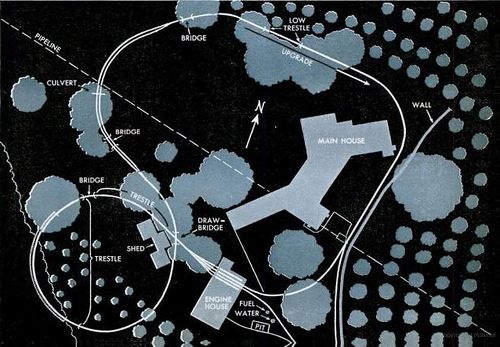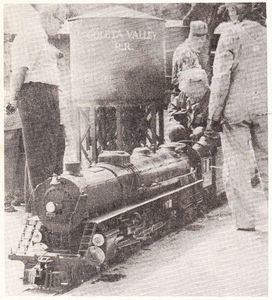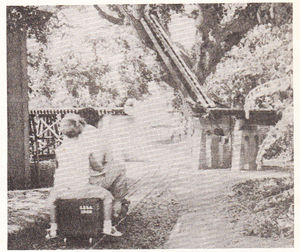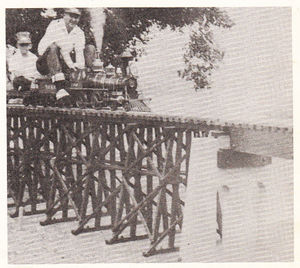Goleta Valley Railroad: Difference between revisions
| Line 34: | Line 34: | ||
The [[Goleta Valley Railroad]] Club has only seven members but they are a going concern with a great amount of enthusiasm, headed up by Seymour himself. You have to be interested in 1-1/2 inch scale and 7-1/2 inch gauge to be eligible. | The [[Goleta Valley Railroad]] Club has only seven members but they are a going concern with a great amount of enthusiasm, headed up by Seymour himself. You have to be interested in 1-1/2 inch scale and 7-1/2 inch gauge to be eligible. | ||
<gallery widths="300px" heights="300px"> | |||
File:GordonCorwin GoletaValleyRR 1956.jpg|[[Gordin Corwin]] taking [[Seymour F. Johnson|Seymour Johnson]]'s 4-8-4 out of the yard. | |||
File:BobHarpur GoletaValleyRR 1956.jpg|[[Bob Harpur]] on the C.P. Huntington ready to go thru the open bridge. | |||
File:DwightDurkeeJr GoletaValleyRR 1956.jpg|[[Dwight Durkee]] Jr. at the throttle of his 4-4-0. | |||
</gallery> | |||
== References == | == References == | ||
* [[Who Ever heard of a Diesel Engine?]] | * [[Who Ever heard of a Diesel Engine?]] | ||
Revision as of 21:48, 5 May 2015
The Goleta Valley Railroad was the first railroad built by Seymour F. Johnson. It was located on the property of his home in Santa Barbara, California.
The track was later moved west of Santa Barbara to become the Goleta Valley Western Railroad.
Harry Dixon wrote in The Miniature Locomotive, November-December 1954
- Seymour F. Johnson, president of the Goleta Valley Line at Santa Barbara, California, has sent news that he expects to have his 1-1/2 inch scale road completed, along with signals and controlled switches, before the summer of 1955. Fellows, this is going to be some railroad, and I will give you more news and views, when completed.
August 1956 Meet
The North American Live Steamer, Volume 1 Number 7, 1956
Story and Photos by Harry L. Dixon
The Goleta Valley Railroad Club was host to some 150 live steamers and friends to celebrate the first anniversary of the club's track at the home of Seymour F. Johnson, Santa Barbara, California.
Sunday, August 19, 1956 was a great day for live steam at this track. The pictures will give you some idea of the most wonderful garden railroad in the Pacific region, if not the entire country. At the present time there is 2500 fee of trackage of which there is 1440 feet for continuous operation. The balance is made up in a passing track, a wye for switching and passenger loading facilities as well as round house track for storing the engines and riding cars. The trestles and bridges are all made to scale and excellent detail throughout. The big trestle is 300 feet long and as you can see at a thrilling height, while at another section of the line there is a 50 foot trestle a little closer to the ground but designed and built to a 3% grade. This railroad is like a huge figure eight and winds through the lemon grove and under magnificent live oaks in addition to passing thru Mrs. Johnson's beautiful rose garden with the Santa Barbara mountains as a fitting background.
Ten stations are whistled up on the trip around, beside going over a bascule bridge, which opens electrically to allow you to pass through after coming off the long trestle.
There were six engines operating most of the time throughout the day, all of which performed in an excellent manner. It was an exceptional experience to see them working. Seymour Johnson was driving his Northern 4-8-4. This engine with tender weights 2000 pounds.
Ray Gifford's workmanship was shown in his 10 wheeler. Robin Smith had his 3 truck Shay fired up and pulled some heavy loads. Bob Harpur operated Little Engines C.P. Huntington with scale box car attached for riding. Dwight Durkee Jr. was able to give his 4-4-0 early American an excellent tryout with very satisfactory results, and member Doc Newton ran his diesel electric with speed and comfort to his passengers.
A very unique operating schedule was used a number of times during the day, with the use of the passing track. An East bound train could start out while a West bound train was loading passengers. After East bound made the circuit, West bound could start out over the big trestle and eventually meet the East bound train at the passing track with no delays. Each making the circuit in approximately 2-1/2 minutes. This operation required three switch men and a bridge tender.
It is planned for the coming year to add to the facilities another 1100 fee of track which will pass through a 200 foot tunnel to a 40 car parking lot.
There you will find a station house and spur tracks for unloading and loading locomotives for such gala events as this.
The Goleta Valley Railroad Club has only seven members but they are a going concern with a great amount of enthusiasm, headed up by Seymour himself. You have to be interested in 1-1/2 inch scale and 7-1/2 inch gauge to be eligible.
Gordin Corwin taking Seymour Johnson's 4-8-4 out of the yard.
Bob Harpur on the C.P. Huntington ready to go thru the open bridge.
Dwight Durkee Jr. at the throttle of his 4-4-0.



